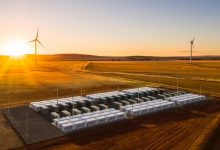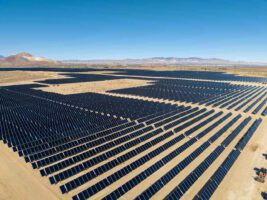A new report has confirmed 2018 as a “remarkable” year for renewable energy in Australia, a year in which – despite the policy quagmire – investment in large-scale projects doubled, and the cost of new wind and solar with storage included was officially declared cheaper than new coal power.
The Clean Energy Council’s latest annual snapshot of the renewable energy industry’s progress describes a year in which many of the records set in 2017 were “smashed.”
Investment in large-scale clean energy projects doubled to more than $20 billion and the amount of renewables capacity in the development pipeline – including those financially committed –increased 260 per cent on 2017, to 14.8 GW in 2018 compared to 5.6 GW in 2017.
In the small-scale solar market, a rooftop solar installation rate averaging at six panels a minute took the nation past the 2 million mark for household systems, and notched up a 45 per cent increase in growth in the commercial market and 43 per cent in the residential sector, to reach a combined installed total of 1.55GW.
In large-scale solar, an average of more than two big solar farms (5MW and over) were commissioned each month in 2018, adding a total of 1442MW of new capacity. A total of 87 projects were under construction or financially committed at the end of 2018.
Wind also had a good year, the report says, with nine new wind farms commissioned, including the 270MW Sapphire Wind Farm in NSW. Another 24 wind farms, with a combined capacity of 5.69 GW, were under construction or financially committed at the end of 2018.
Battery storage, meanwhile, gained some important ground, with a growing number of grid-scale systems completed across the country, including the 30MWh Ballarat Energy Storage System in Victoria; the 30MW/8MWh Dalrymple Energy Storage for Commercial Renewable Integration in South Australia; the 25MW/50MWh Gannawarra Energy Storage System, again in Victoria; and the 5MW Alice Springs Battery Energy Storage System in the NT.
“The benefits of utility-scale batteries were clearly demonstrated by the Hornsdale Power Reserve in 2018, which was found to have reduced frequency control ancillary services costs by up to $50 million. These cost reductions could be even greater if the rules of the National Electricity Market are changed to support fast frequency response,” the report said.
As for small-scale batteries, the report notes that 2019 is shaping up as the year for this sub-sector, with government support expected to result in the number of households with batteries tripling to 70,000, and give Australia a 30 per cent share of the global household battery market by the year’s end.
In terms of the broader grid, the report notes that the National Electricity Market had historically high levels of reliability in 2018, despite the need for occasional load shedding during periods of extreme heat.
It points to the early 2019 Grattan Institute report that determined that Australia’s energy system had become, if anything, more reliable with greater amounts of renewable energy.
The Grattan report found that 98 per cent of outages over the past decade were caused by problems in transporting and distributing electricity – not the technology that generated it.
It also argued that misconceptions about the impact of renewables on system reliability could lead to overreactions and knee-jerk policy, which in turn could see electricity bills rise even higher.
This contrasts with the findings of an AEMC report on grid performance, also published on Thursday morning, that has immediately sparked mainstream media reports declaring that the 2018 influx of solar and wind generation has resulted in a “daily fight to keep the lights on.”
On electricity prices, the CEC notes that those stayed stubbornly high in 2018, but says that the considerable amount of new wind and solar capacity that has entered the market is already starting to push down on wholesale prices.
“The cost of new wind and solar – even when backed by storage – is now lower than the cost of new coal generation, meaning that wholesale prices should continue to fall as more clean energy
comes online.”
Australia’s energy politics, meanwhile, remained problematic in 2018. And the CEC report flags growing concerns that if this continues throughout 2019, there could be serious consequences for the renewables industry.
“Unfortunately, the politics around energy reached another new low in 2018, with the federal government opting to tear itself apart rather than implement its own National Energy Guarantee,” said CEC CEO Kane Thornton in the report.
“While the 2019 Federal Election will create another pivotal year for clean energy in Australia, we have thankfully reached a point where politics isn’t as existential to the industry as it once was.”










